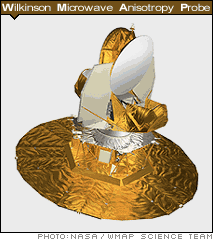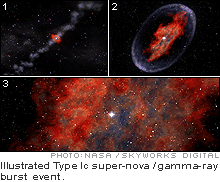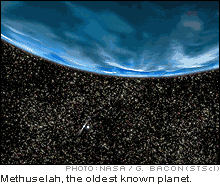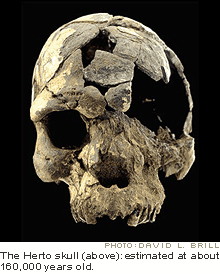“Rotting Y” Redeemed

 |
In one of the most important cosmological discoveries in years, NASA scientists have captured the most precise image of the universe, shedding light on its origins and age, and providing further evidence for the long-standing Big Bang and inflation theories. In Feb. 2003, a joint NASA–Princeton University satellite, the Wilkinson Microwave Anisotropy Probe (WMAP), produced a high-resolution map that captured the oldest light in the universe. This ancient light, called the cosmic microwave background, is the cooled remnant of the hot explosion known as the Big Bang. “The cosmic microwave light is a fossil,” explained David Wilkinson, after whom the probe was named. “Just as we can study dinosaur bones and reconstruct their lives of millions of years ago, we can probe this ancient light and reconstruct the universe as it was.” (Wilkinson died just before WMAP's remarkable findings were published.)
The age of the universe has now been accurately determined—with just a 1% margin of error—as 13.7 billion years old (previous estimates ranged between 8–20 billion years old). The birth of stars has been pinpointed to just 200 million years after the Big Bang, a surprise to most scientists (predictions had ranged from 500 million to 1 billion years after the cosmos formed). The WMAP image also revealed the contents of the universe: only 4% is made up of atoms, or the physical universe as we know it. The remainder is made up of poorly understood substances: dark energy (73%) and dark matter (23%). These findings are consistent with the Big Bang and inflation theories, which assert that the universe materialized in a “big bang” and immediately began cooling and expanding. “I think every astronomer will remember where they were when they heard these results,” said John Bahcall, a Princeton University astrophysicist. “I certainly will. This announcement represents a rite of passage for cosmology from speculation to precision science.”
Violent Gamma Rays Apprehended
 |
The mystery of gamma-ray bursts—the universe's most powerful explosions, which release as much energy as a billion trillion suns—has baffled scientists ever since they were first identified in 1973. Lasting only seconds and appearing at random, these maddeningly unpredictable flashes of astounding energy eluded the watchful eyes of the world's scientists—that is, until the early hours of March 29, 2003, when a satellite finally caught a particularly brazen one in flagrante delicto. This gamma-ray burst was particularly long-lasting (30 seconds), bright (a trillion times more luminous than the Sun), and tantalizingly close (just 2 billion, as opposed to the usual 10–12 billion, light-years away). The afterglow continued for an unprecedented two weeks, a lucky break that finally gave scientists the evidence they had been looking for.
Gamma-ray bursts, it turns out, are none other than supernovae—explosions associated with the violent deaths of massive stars, something that many scientists had suspected but could not prove. “We've been searching for a direct link for decades, and we finally got it,” said NASA's Donald Kniffen. Astronomer Brian Lee of Lawrence Berkeley National Laboratory registered relief that the long hunt is finally over: “It just leaves one slightly stunned to be looking for an answer for 12 years, have so many hints and false guesses, and then one day just have the answer. There are still lots of questions, but no one is guessing about the main one any more.”
Precocious Planet
 |
The Hubble telescope has detected the oldest known planet—and it appears to have been formed billions of years earlier than astronomers thought possible. Nicknamed Methuselah after the aged biblical patriarch, the planet is an astonishing 12.7 billion years old. In contrast, all other known planets (including our own) were created about 8 billion years later, roughly 4.5 billion years ago. Methuselah's age is causing astronomers to reevaluate the prevalent theory of planet formation, which argues that the early universe did not contain sufficient heavy elements (e.g., carbon, silicon, and oxygen) to allow for planets to form. But Methuselah defies this theory, having debuted when the primordial universe had only one-thirtieth of the heavy elements existing when our own solar system was born.
160,000 Years Ago, Our Forefathers…
 |
Three fossilized skulls discovered near the Ethiopian village of Herto in 1997 have now been identified as the oldest known remains of modern humans. Assigned to a new human subspecies called Homo sapiens idaltu (idaltu means elder in the Afar language of Ethiopia), the skulls are estimated to be about 160,000 years old—a good 50,000 years older than any previously discovered Homo sapiens. The Herto discovery helps resolve two major debates in paleontology: whether humans are related to Neanderthals and whether all modern humans originated in Africa or developed simultaneously in other regions of the world. These skulls suggest that modern humans existed thousands of years before the Neanderthals evolved in Europe, which would confirm that Homo sapiens neanderthalis was not a rung on the evolutionary ladder leading to Homo sapiens sapiens (that's us) but an entirely separate offshoot of hominid that eventually went extinct. The Herto find also supports the “Out of Africa” hypothesis, which contends that all modern humans developed within Africa and then migrated elsewhere, and refutes the multiregional hypothesis, which claims that modern humans developed in various parts of the world at roughly the same time. The earliest human fossils found outside Africa are much younger than the 160,000-year-old Herto skulls. Berkeley paleoanthroplogist Tim White, one of the find's principal scientists, is convinced that Herto is “the critical missing data” that supports the Out of Africa theory. “All people,” he contends, “every one of us living today, is ultimately African.”
A Younger Mungo
After years of contentious debate, scientists have finally agreed on the age of Mungo Man, Australia's oldest Homo sapien discovery. Originally thought to be 62,000 years old, new testing released in Feb. 2003 has definitively shaved 22,000 years off his age. “The consensus was unanimous—Mungo Man was buried about 42,000 years ago, ” says geologist Jim Bowler of the University of Melbourne, who discovered Mungo Man in 1974 in the dry bed of Lake Mungo in New South Wales. Mungo Man is the oldest ritually buried skeleton in the world—his body was painted with ochre.
Mungo Man's revised age is not merely a victory for the advancement of scientific testing, but it makes also an important contribution to the theories of human evolution. Had Mungo Man been 62,000 years old as originally determined, the multiregionalist view of human development would have received an important boost. Multiregionalists maintain that an early human ancestor, Homo erectus, left Africa between 1 and 2 million years ago and then evolved into modern Homo sapiens in various regions of the world. Since, as most paleontologists agree, early humans could not have migrated swiftly enough from Africa to arrive in Australia before 50,000 years ago, a 62,000-year-old Mungo suggests that modern humans had evolved independently in Australia. But a sprightly 42,000-year-old Mungo lends support to the “Out of Africa” hypothesis (the more prevalent view among paleontologists) that anatomically modern humans left Africa and arrived in Australia around 50,000 years ago. Mungo Man's Homo sapien ancestors from Africa would have had plenty of time to make their way to far-flung Australia before young Mungo appeared on the scene.
It's a Bird…It's a Dino… It's Microraptor!
Scientists have uncovered the fossil of a new species of flying dinosaur in northeastern China thought to have existed 120 million years ago. Discovered in Feb. 2003, it is the first dinosaur ever found with four wings. The Chinese team that found the dinosaur has named it Microraptor gui, after Chinese paleontologist Gu Zhiwei. The creature may have lived in trees, perhaps gliding from branch to branch. Related to the Tyrannosaurus rex, though much smaller—from head to tail the tiny raptor measures just 30 inches—it resembles a flying squirrel more than a formidable carnivore. Scientists hope Microraptor gui may prove the link between dinosaurs and birds—some scientists have hypothesized that birds evolved directly from dinosaurs, but thus far there hasn't been enough evidence to prove this. “It is a beautiful mix of dinosaur and bird…it's so unique,” commented paleontologist Nick Czaplewski of the Sam Noble Oklahoma Museum of Natural History. “It's a very interesting critter no matter how it's classified.”
T. Rex—Maybe Not so Tough After All
Paleontologist Jack Horner has challenged conventional notions of T. rex as a savage predator. Horner argues that T. rex was not a hunter but a scavenger, which puts him more in league with hyenas and vultures than other ferocious beasts of prey. Horner believes that T. rex was too slow, its forelegs too short, and its eyes too small to make it an effective predator. Most likely, Horner maintains, T. rex simply bullied or scared away carnivorous dinosaurs after they had killed their prey and then stole their food. Horner, a colorful and celebrated paleontologist (Alan Grant, the scientist in Steven Spielberg's Jurassic Park, is believed to have been based on him) is apologetic that his T. rex theory has tarnished the reputation of the king of dinosaurs. “Almost every kid, almost everybody in the world, hates the idea of T. rex being a scavenger,” said Horner.
The Dark Side of Dinosaurs
Scientists studying dinosaur bones from Madagascar have discovered a dinosaur who wasn't just a run-of-the-mill carnivore—the 65-million-year-old Majungatholus atopus, a two-legged dinosaur from the Cretaceous period, is believed to have feasted on members of its own species. After examining the jaws and teeth of other contemporaneous Madagascan dinosaurs for likely suspects, the researchers concluded that this had been a Majungatholus-on- Majungatholus crime. “With these other candidates eliminated, Majungatholus atopus stands accused of cannibalism and is presumed guilty until proven innocent, which, in my opinion, is unlikely to happen,” said one of the scientists, David Krause of SUNY–Stony Brook. This is the first genuine evidence that a dinosaur species practiced cannibalism. But according to the journal Nature, the Majungatholus was hardly the only cannibal in the animal kingdom, and today cannibalism is practiced by a variety of creatures, ranging from mice to lions.
Life in the Underground
Far below the ocean floor thrives a world of microbes, according to scientists from Oregon State University. The scientists drilled 1,000 feet beneath the bottom of the ocean, first through 825 feet of ocean-floor sediment and then through 175 feet of basalt, deep within the Earth's 3.5 million-year-old crust. The samples they collected turned up a profusion of bacterial life within this seemingly hostile environment. Living amid basalt crevices in hot water reaching 149°F (65°C), these microscopic creatures survive on inorganic molecules such as sulphide, hydrogen, and carbon dioxide (most living beings consume organic molecules). “This is one of the best views we've ever had of this difficult-to-reach location in the Earth's crust and the life forms that live in it,” said Michael Rappe, one of the researchers. “Until now we knew practically nothing about the biology of areas such as this, but we found about the same amount of bacteria in that water as you might find in surrounding seawater in the ocean. It was abundant.”
“Rotting Y” Redeemed
In June 2003, scientists published the first comprehensive analysis of the genetic code of the Y chromosome. Geneticists have always been somewhat dismissive of the Y chromosome, which provides just 78 genes out of the estimated 30,000 in human DNA and makes few important contributions beyond determining gender (females have two X chromosomes; males have an X and a Y chromosome). Once the size of the X chromosome, which contains about 1,000 genes, the Y chromosome has been rapidly decaying over the course of human evolution, dwindling to a mere tenth of its former self. While the X chromosome comes in pairs and uses its partner to regenerate, the Y stands alone. Consequently, many scientists have subscribed to the “rotting Y” theory, which holds that the Y, unable to recombine, will continue to degenerate over the next 5 million years or so, eventually becoming extinct. But now scientists have gained a new respect for the Y's ingenuity and powers of survival—written off as a degenerate loner, the Y in fact shows impressive signs of pulling itself up by its bootstraps. The Y chromosome is in fact capable of repairing its most crucial genes, and it does so all on its own: “denied the benefits of recombining with the X, the Y recombines with itself.” According to one of the lead researchers, Richard K. Wilson of the Genome Sequencing Center at Washington University School of Medicine in St. Louis, “This study shows that the Y chromosome has become very efficient at preserving its important genes. It's found different ways to do the things chromosomes must do to evolve, survive, and thrive.” The news has gladdened another lead researcher, MIT geneticist David Page, who considers it his duty to “defend the honor of the Y chromosome in the face of a century of insults.”







